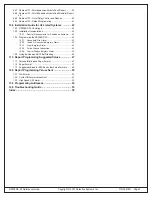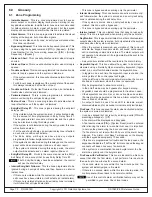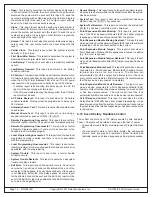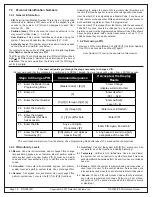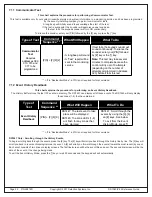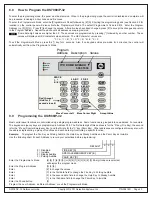
Page 10 P/N 39818D Copyright © 2001 Detection Systems, Inc. DS7080iP-32 Reference Guide
6.0
Glossary
6.1
Zone Programming
• Invisible Alarms: This is a zone programmed not to have an
alarm output or an alarm display (except when arming) at any
keypad when activated. Invisible Alarm zones are recommended
for holdup alarms. An alarm signal will be sent, but the keypad
display will not indicate an alarm while this zone is violated.
• Silent Alarms: This is a zone programmed to activate the visual
display at the keypad, but not audible signals.
- If this zone is also an entry zone, an entry tone will sound when
this zone is activated.
• Bypassing Allowed: This zone can be bypassed (shunted). This
is done using the bypass command ([PIN] + [Bypass] + [2-Digit
Zone Number]) or the force arming sequence ([PIN] + [Arming
Sequence] + [Bypass]).
• Alarm on Short: This zone will activate an alarm when its loop is
shorted.
• Alarm on Open: This zone will activate an alarm when its loop is
opened.
• Trouble on Open: This is a zone programmed to activate a trouble
when its loop is opened and the system is disarmed.
- If the system is armed, this zone will activate an alarm if shorted
or opened.
- For 24-hour zones, regardless of the arming state of the panel,
this always remains as a Trouble on Open.
• Trouble on Short: Works like Trouble on Open, but activates a
trouble when shorted and disarmed.
• Perimeter Instant: This is a zone programmed to activate an
alarm even during the entry/exit delay period.
• 24-Hour Zone: This is a zone programmed to activate when its
loop is faulted, even if the system is disarmed.
• Entry/Exit Delay #1: This zone is ignored during the entry/exit
delay period.
- If it is violated while the system is armed, it will activate a delay
for the amount of time programmed in Entry Delay Time #1.
The keypad pre-alert sounders will activate and the system
may be disarmed during this delay period.
- If the system is not disarmed during the entry period, this zone
will activate an alarm.
- If, at the end of an Exit delay, an entry/exit delay zone is faulted,
an exit error condition will activate.
- The Entr y delay will begin as above and any outputs
programmed to follow burglar alarms will activate.
- If the system is not disarmed during this delay period, the control
panel will send an alarm report and an exit error report.
- If the system is disarmed during this delay period, the alarm
outputs will deactivate and no alarm report will be sent.
• Entry/Exit Delay #2: Works in the same manner as the Entry/
Exit Delay #1 zone, except that it uses Entry Delay Time #2.
If both Entry/Exit delays have been activated, the control
will use the shorter delay.
• Interior Entry/Exit Follower: This is a zone programmed to be
ignored during an entry/exit delay and then become an interior
instant zone.
- If this zone is violated while the system is armed and no entry/
exit zones have been violated, it will activate an instant alarm.
- If this zone is violated after an entry/exit delay zone is violated,
it will follow that entry/exit delay time.
- This zone is bypassed when arming only the perimeter.
• Interior Home/Away: This zone becomes an active interior entry/
exit follower when the system is armed and an entry/exit delay
zone is violated during the exit delay time.
- If the system is armed and an entry/exit delay zone is not
violated, this zone will be bypassed.
- This zone is bypassed when arming only the perimeter.
• Interior Instant: This is an instant zone that does not use entry
delays. This zone is bypassed when arming only the perimeter.
• Day Monitor: This is a perimeter instant zone that activates alarm
outputs when the system is armed, but only activates the keypad
sounders when the system is disarmed.
- When the system is disarmed, any violation of this zone will
activate the keypad sounders which will sound continuously
until a disarming command is entered. The alarm outputs will
not operate. A trouble report (if programmed) will be sent to the
central station.
- A day monitor violation will be recorded in the alarm history.
• Keyswitch Input: This zone allows the system to be armed or
disarmed using a Normally Open momentary keyswitch (toggle
mode) or an on/off switch wired across the keyswitch zone.
- In toggle mode, each time the keyswitch input is shorted, the
arming state of the control panel will toggle.
- In the on/off mode, the control panel will arm when the zone is
shorted and will disarm when the zone is supervised.
- May be programmed to allow force arming.
- In the on/off mode, may be bypassed for keypad arming.
- Keyswitch zones should be programmed for trouble on open.
- If the keyswitch zone circuit is cut, a zone trouble and an alarm
(if armed) will be generated on this zone. Alarm output for this
zone is fixed at on steady.
- An output should be used for an LED to indicate armed/
disarmed status and for a sounder to indicate entry/exit delays.
• Fire Zone: This zone causes a fire alarm when activated, whether
the system is armed or disarmed.
- It can be silenced (but not reset) by entering a valid [PIN with
disarming privileges] + [Off].
- A fire alarm will be displayed on all keypads.
- A fire reset command [PIN] + [System Reset] must be entered
after silencing the alarm to re-enable this zone. It is important
to not use the panel during the 8 second reset period.
- If a fire alarm is not reset within 24 hours of the alarm being
silenced, “Fire Alarm…Not Reset” will appear on the display
with the keypad beeping every 10 seconds.
- If this zone is programmed for trouble and the loop opens, the
keypads will indicate a “Fire Trouble” for this zone and the keypad
sounders will beep once every ten seconds.
- If the system is a combination fire and burglar alarm, the fire
alarm has priority over the burglar alarm.
• Fire Zone with Verification: This zone is identical to a fire zone
except that after the first alarm, it will perform a fire reset and
then wait up to two minutes for a second alarm.
- If a second alarm occurs within this two minute period, the
system will instantly signal a fire alarm.
- If there is no second alarm within this two minute period, the
control panel will reset back to its normal condition.
Use of this control’s alarm verification feature may not be
permitted in your area. Check local codes.



